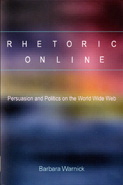Source
One way in which audiences of Web-based rhetorical artifacts participate in co-creating meaning is by judging the ethos of the artifact and its source(s). This judgment is complicated by the fact that many websites give no indication of who created site content. Warnick cites a study of Web user comments finding that users judge site ethos by factors such as visual design and layout, information structure, and usefulness rather than by who wrote site content.
The Web is a communication environment that fosters collaborative authorship by teams. Indeed, many of the most-visited sites on the Web could not possibly be maintained by one person. For example, wikis such as Wikipedia are continually written, edited, and argued about by individuals all over the world. Moreover, variables such as modifiable templates or users' browser settings complicate who has control over the boundaries of authorship. For example, I adapted an open-source template to craft the webtext version of this review. In a sense, the individual who created that template and your particular browser settings are my co-authors.
Message
Drawing on Lev Manovich's work theorizing what makes new media “new,” Warnick points out that Web texts are modular. They are made up of bits of code, images, media, hyperlinks, and other components. These components can in turn be altered and repurposed, such as I have altered and repurposed an open-source template for this review.
While repurposing media is not unique to the Web, the sheer abundance of raw materials available, the ease with which they may be manipulated, and the availability of software that allows one to peek behind the curtain to see (and tweak) code or alter images makes the Web a place where messages are fragmentable and infinitely repurposeable.
Time
Warnick contends that even though they are potentially aimed at large audiences, Web texts are not aimed at mass audiences in the same sense that broadcast television is. That is, Web texts are intended to be available any time a user wishes to access them. The user sets the schedule, not the identifiable authors or sponsors.
Time not only affects when a user experiences a Web text, it also affects how she does so. Variations in computer processing power and bandwidth can radically alter how the user experiences all the affordances (such as Flash animation, streaming audio and video, images) that a Web site might have to offer.
Time also—and this is the most important aspect of time from a researcher's perspective—affects the permanence of Web artifacts. Even the highly useful and ambitious Internet Archive (IA), which holds billions of pages, is essentially a storehouse of incremental snapshots of certain elements of pages, with second- and third-level links and content stored on other servers missing. Warnick explains that the effect of this kind of snapshot archiving is that rhetorical critics are hard-pressed to have available the dynamics of page use as they existed for users on the date of the snapshot. What's more, as I know from my own research, site owners can opt out of archiving by the IA, leaving critics to cobble together their own means of capturing site content and dynamics. As Warnick later puts it, “the challenges in archiving the political Web are nearly insuperable” (124).
For these reasons, Warnick calls for rhetorical critics to serve what amount to archival and recovery functions. By providing rich descriptions and analyses of ephemeral Web artifacts, at least much of the dynamism and importance of a Web-based rhetorical artifact can live on even if the artifact itself cannot be otherwise preserved. Feminist scholars reexamining the history of rhetoric have already shown the ample benefits of recovery and archival work for purposes of better understanding what counts as “rhetoric” and who counts as a rhetorician worthy of study. Warnick’s call to action in the digital realm is no less important, and it may be more urgent. Manuscripts and historical evidence tend to be more durable than many Web artifacts.
